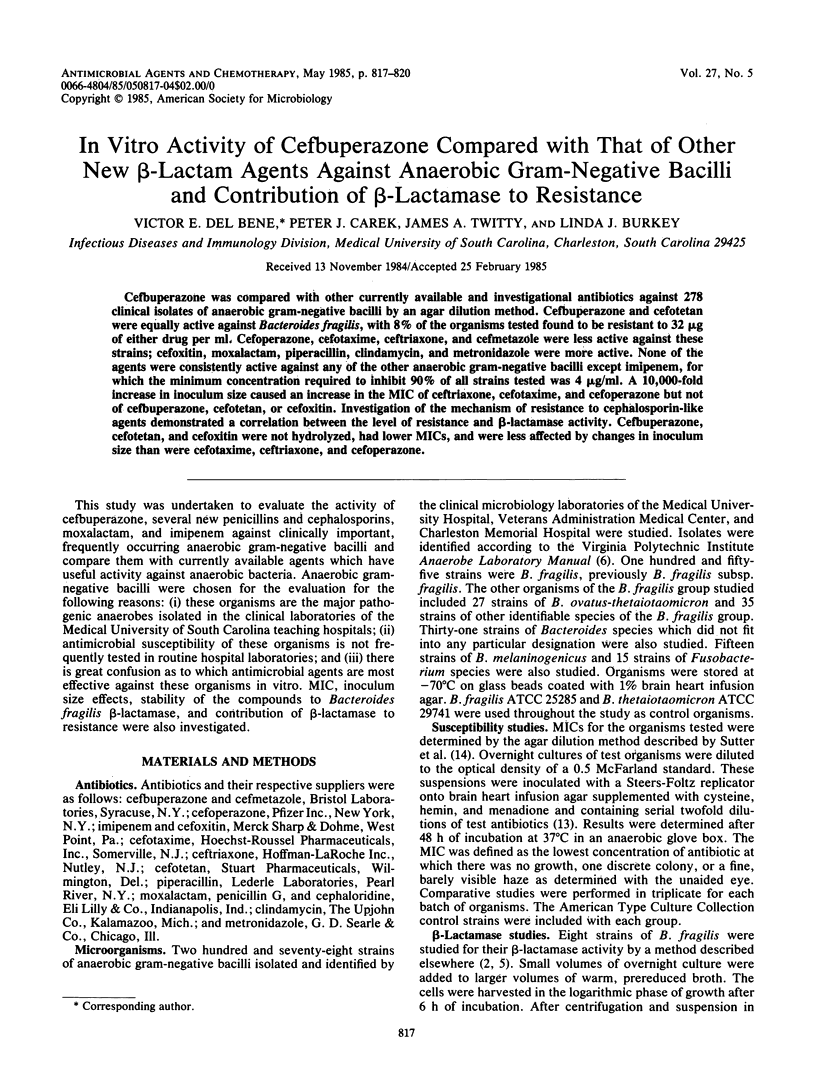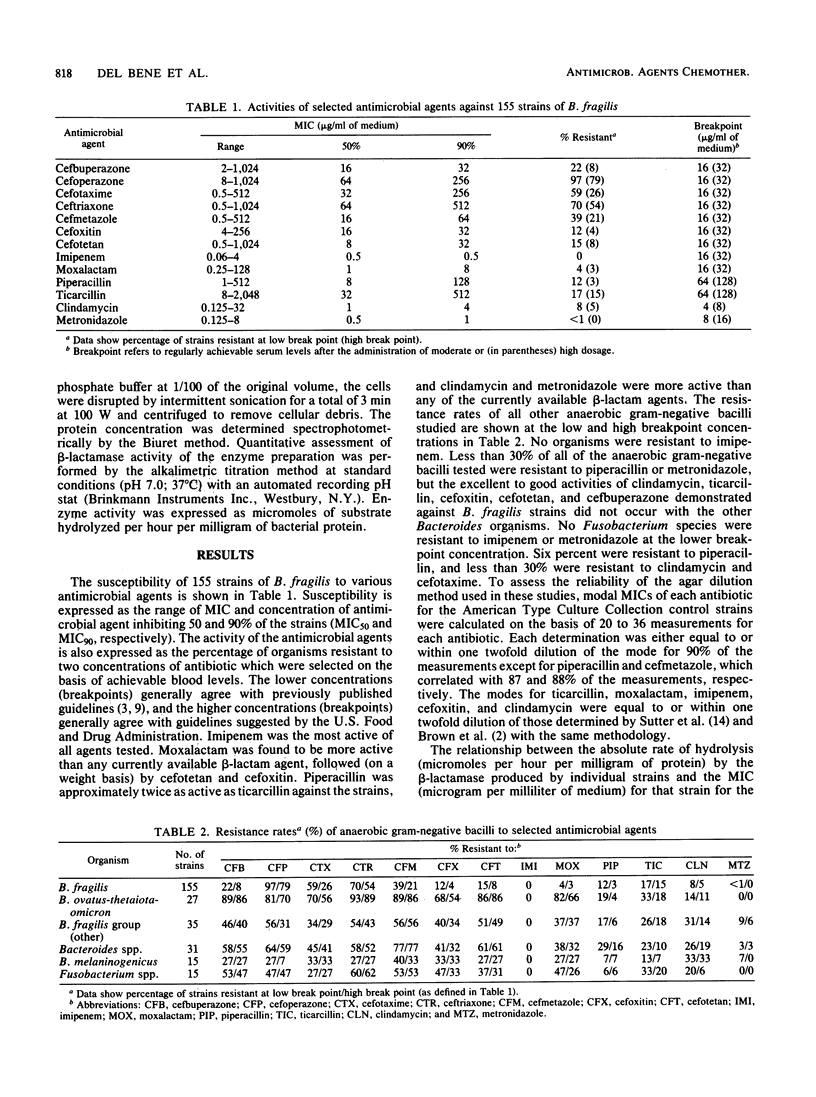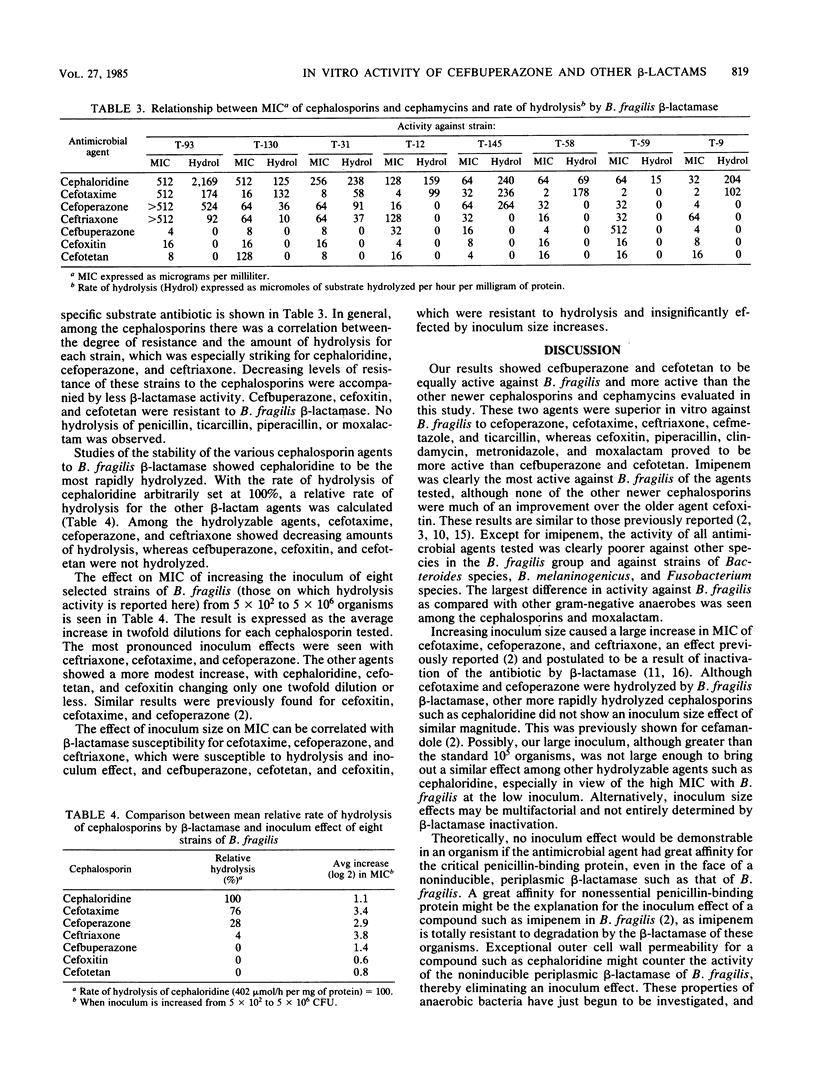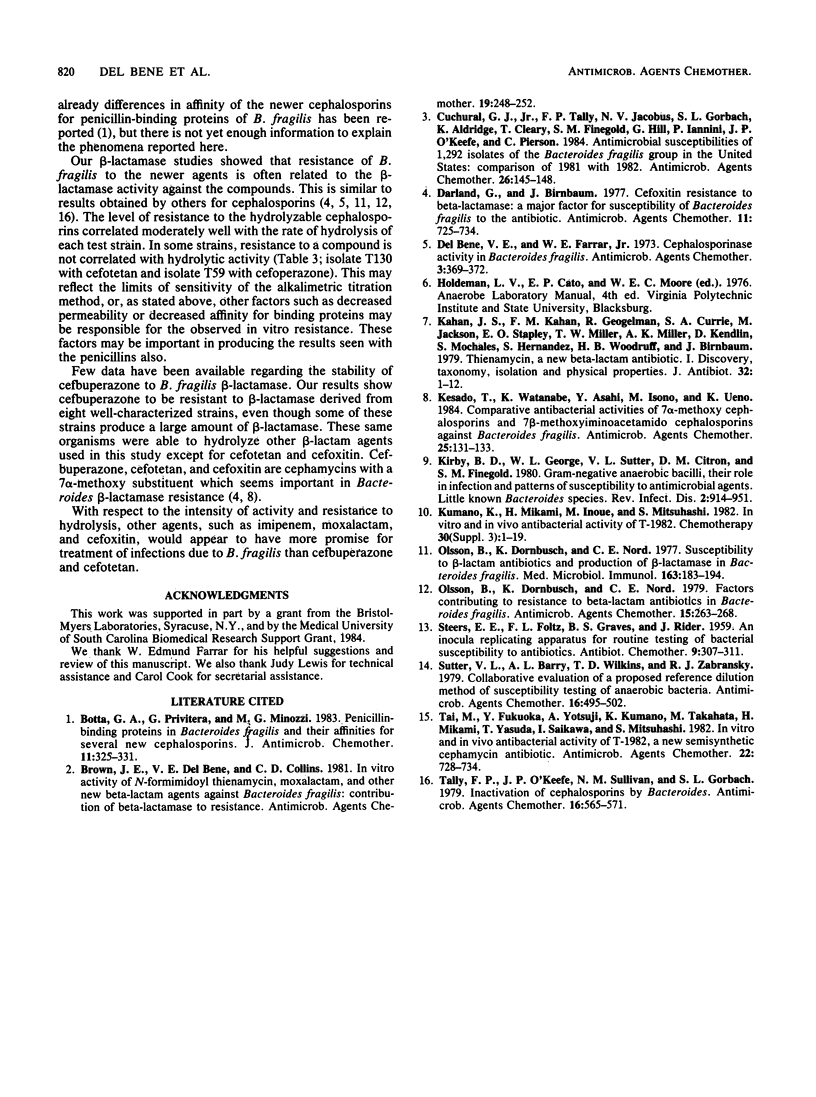Abstract
Cefbuperazone was compared with other currently available and investigational antibiotics against 278 clinical isolates of anaerobic gram-negative bacilli by an agar dilution method. Cefbuperazone and cefotetan were equally active against Bacteroides fragilis, with 8% of the organisms tested found to be resistant to 32 micrograms of either drug per ml. Cefoperazone, cefotaxime, ceftriaxone, and cefmetazole were less active against these strains; cefoxitin, moxalactam, piperacillin, clindamycin, and metronidazole were more active. None of the agents were consistently active against any of the other anaerobic gram-negative bacilli except imipenem, for which the minimum concentration required to inhibit 90% of all strains tested was 4 micrograms/ml. A 10,000-fold increase in inoculum size caused an increase in the MIC of ceftriaxone, cefotaxime, and cefoperazone but not of cefbuperazone, cefotetan, or cefoxitin. Investigation of the mechanism of resistance to cephalosporin-like agents demonstrated a correlation between the level of resistance and beta-lactamase activity. Cefbuperazone, cefotetan, and cefoxitin were not hydrolyzed, had lower MICs, and were less affected by changes in inoculum size than were cefotaxime, ceftriaxone, and cefoperazone.
Full text
PDF



Selected References
These references are in PubMed. This may not be the complete list of references from this article.
- Botta G. A., Privitera G., Menozzi M. G. Penicillin-binding proteins in Bacteroides fragilis and their affinities for several new cephalosporins. J Antimicrob Chemother. 1983 Apr;11(4):325–331. doi: 10.1093/jac/11.4.325. [DOI] [PubMed] [Google Scholar]
- Brown J. E., Del Bene V. E., Collins C. D. In vitro activity of N-formimidoyl thienamycin, moxalactam, and other new beta-lactam agents against Bacteroides fragilis: contribution of beta-lactamase to resistance. Antimicrob Agents Chemother. 1981 Feb;19(2):248–252. doi: 10.1128/aac.19.2.248. [DOI] [PMC free article] [PubMed] [Google Scholar]
- Cuchural G. J., Jr, Tally F. P., Jacobus N. V., Gorbach S. L., Aldridge K., Cleary T., Finegold S. M., Hill G., Iannini P., O'Keefe J. P. Antimicrobial susceptibilities of 1,292 isolates of the Bacteroides fragilis group in the United States: comparison of 1981 with 1982. Antimicrob Agents Chemother. 1984 Aug;26(2):145–148. doi: 10.1128/aac.26.2.145. [DOI] [PMC free article] [PubMed] [Google Scholar]
- Darland G., Birnbaum J. Cefoxitin resistance to beta-lactamase: a major factor for susceptibility of bacteroides fragilis to the antibiotic. Antimicrob Agents Chemother. 1977 Apr;11(4):725–734. doi: 10.1128/aac.11.4.725. [DOI] [PMC free article] [PubMed] [Google Scholar]
- Del Bene V. E., Farrar W. E., Jr Cephalosporinase activity in Bacteroides fragilis. Antimicrob Agents Chemother. 1973 Mar;3(3):369–372. doi: 10.1128/aac.3.3.369. [DOI] [PMC free article] [PubMed] [Google Scholar]
- Kahan J. S., Kahan F. M., Goegelman R., Currie S. A., Jackson M., Stapley E. O., Miller T. W., Miller A. K., Hendlin D., Mochales S. Thienamycin, a new beta-lactam antibiotic. I. Discovery, taxonomy, isolation and physical properties. J Antibiot (Tokyo) 1979 Jan;32(1):1–12. doi: 10.7164/antibiotics.32.1. [DOI] [PubMed] [Google Scholar]
- Kesado T., Watanabe K., Asahi Y., Isono M., Ueno K. Comparative antibacterial activities of 7 alpha-methoxy cephalosporins and 7 beta-methoxyiminoacetamido cephalosporins against Bacteroides fragilis. Antimicrob Agents Chemother. 1984 Jan;25(1):131–133. doi: 10.1128/aac.25.1.131. [DOI] [PMC free article] [PubMed] [Google Scholar]
- Kirby B. D., George W. L., Sutter V. L., Citron D. M., Finegold S. M. Gram-negative anaerobic bacilli: their role in infection and patterns of susceptibility to antimicrobial agents. I. Little-known Bacteroides species. Rev Infect Dis. 1980 Nov-Dec;2(6):914–951. doi: 10.1093/clinids/2.6.914. [DOI] [PubMed] [Google Scholar]
- Olsson B., Dornbusch K., Nord C. E. Factors contributing to resistance to beta-lactam antibiotics in Bacteroides fragilis. Antimicrob Agents Chemother. 1979 Feb;15(2):263–268. doi: 10.1128/aac.15.2.263. [DOI] [PMC free article] [PubMed] [Google Scholar]
- Olsson B., Dornbusch K., Nord C. E. Susceptibility to beta-lactam antibiotics and production of beta-lactamase in Bacteroides fragilis. Med Microbiol Immunol. 1977 Oct 7;163(3):183–194. doi: 10.1007/BF02126677. [DOI] [PubMed] [Google Scholar]
- Sutter V. L., Barry A. L., Wilkins T. D., Zabransky R. J. Collaborative evaluation of a proposed reference dilution method of susceptibility testing of anaerobic bacteria. Antimicrob Agents Chemother. 1979 Oct;16(4):495–502. doi: 10.1128/aac.16.4.495. [DOI] [PMC free article] [PubMed] [Google Scholar]
- Tai M., Fukuoka Y., Yotsuji A., Kumano K., Takahata M., Mikami H., Yasuda T., Saikawa I., Mitsuhashi S. In vitro and in vivo antibacterial activity of T-1982, a new semisynthetic cephamycin antibiotic. Antimicrob Agents Chemother. 1982 Nov;22(5):728–734. doi: 10.1128/aac.22.5.728. [DOI] [PMC free article] [PubMed] [Google Scholar]
- Tally F. P., O'Keefe J. P., Sullivan N. M., Gorbach S. L. Inactivation of cephalosporins by Bacteroides. Antimicrob Agents Chemother. 1979 Nov;16(5):565–571. doi: 10.1128/aac.16.5.565. [DOI] [PMC free article] [PubMed] [Google Scholar]


